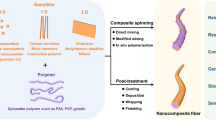Abstract
The morphological characteristic of electrospun polyacrylamide/multi-walled carbon nanotube (PAAm/MWCNTs) nanocomposite nanofibers is optimized in this work using Taguchi’s experimental design. The optimization is performed considering the effect of PAAm concentration, MWCNTs content, flow rate, and applied voltage on average nanofibers diameter. The reasonable dispersion of MWCNTs in PAAm solution is first ascertained via optical microscopy method. The experimental data required for the optimization process are then provided by statistical calculations on field-emission scanning electron microscopy images of the samples formulated based on a designed L 9 orthogonal array. PAAm concentration is found to have the most contribution on final fibers morphology according to the results obtained from simultaneous implementation of the analysis of variance and mean effect assessment. Therefore, PAAm concentration, which is in consistence with solution viscosity and surface tension parameter, is found to have the most contribution to forming nanofibers including the finest fiber diameter. On the contrary, the flow rate of solution among the selected parameters shows the least effect on average nanofiber diameter.
Similar content being viewed by others
References
Huang Z-M et al (2003) A review on polymer nanofibers by electrospinning and their applications in nanocomposites. Compos Sci Technol 63(15):2223–2253
Bhardwaj N, Kundu SC (2010) Electrospinning: a fascinating fiber fabrication technique. Biotechnol Adv 28(3):325–347
Patra S, Lin R, Bhattacharyya D (2010) Regression analysis of manufacturing electrospun nonwoven nanotextiles. J Mater Sci 45(14):3938–3946
Jack KS et al (2009) The fabrication and characterization of biodegradable HA/PHBV nanoparticle-polymer composite scaffolds. Acta Biomaterialia 5(7):2657–2667
Liu X, Won Y, Ma PX (2006) Porogen-induced surface modification of nano-fibrous poly(l-lactic acid) scaffolds for tissue engineering. Biomaterials 27(21):3980–3987
Jansen EJP et al (2005) Hydrophobicity as a design criterion for polymer scaffolds in bone tissue engineering. Biomaterials 26(21):4423–4431
Liang D, Hsiao BS, Chu B (2007) Functional electrospun nanofibrous scaffolds for biomedical applications. Advanced Drug Delivery Reviews 59(14):1392–1412
Jang J-H, Castano O, Kim H-W (2009) Electrospun materials as potential platforms for bone tissue engineering. Advanced Drug Delivery Reviews 61(12):1065–1083
Boland ED et al (2005) Electrospinning polydioxanone for biomedical applications. Acta Biomaterialia 1(1):115–123
Lannutti J et al (2007) Electrospinning for tissue engineering scaffolds. Materials Science and Engineering: C 27(3):504–509
Lee KY et al (2009) Electrospinning of polysaccharides for regenerative medicine. Advanced Drug Delivery Reviews 61(12):1020–1032
Yoon JJ, Kim JH, Park TG (2003) Dexamethasone-releasing biodegradable polymer scaffolds fabricated by a gas-foaming/salt-leaching method. Biomaterials 24(13):2323–2329
Sill TJ, von Recum HA (2008) Electrospinning: applications in drug delivery and tissue engineering. Biomaterials 29(13):1989–2006
Elsner JJ, Zilberman M (2009) Antibiotic-eluting bioresorbable composite fibers for wound healing applications: microstructure, drug delivery and mechanical properties. Acta Biomaterialia 5(8):2872–2883
Rho KS et al (2006) Electrospinning of collagen nanofibers: effects on the behavior of normal human keratinocytes and early-stage wound healing. Biomaterials 27(8):1452–1461
Qin X-H, Wang S-Y (2006) Filtration properties of electrospinning nanofibers. J Appl Polym Sci 102(2):1285–1290
Ding B et al (2009) Gas sensors based on electrospun nanofibers. Sensors 9(3):1609–1624
Li Z et al (2008) Highly sensitive and stable humidity nanosensors based on LiCl doped TiO2 electrospun nanofibers. J Am Chem Soc 130(15):5036–5037
Wang X et al (2002) Electrospun nanofibrous membranes for highly sensitive optical sensors. Nano Letters 2(11):1273–1275
Lei X et al (2011) Influence of fabricating process on gas sensing properties of ZnO nanofiber-based sensors. Chin Phys Lett 28(4):040701
Lei X et al (2011) Micro humidity sensor with high sensitivity and quick response/recovery based on ZnO/TiO2 composite nanofibers. Chin Phys Lett 28(7):070702
Ko F et al (2003) Electrospinning of continuous carbon nanotube-filled nanofiber yarns. Adv Mater 15(14):1161–1165
Mazinani S, Ajji A, Dubois C (2009) Morphology, structure and properties of conductive PS/CNT nanocomposite electrospun mat. Polymer 50(14):3329–3342
Baji A, Mai Y-W, Wong S-C (2011) Effect of fiber diameter on the deformation behavior of self-assembled carbon nanotube reinforced electrospun polyamide 6,6 fibers. Mater Sci Eng, A 528(21):6565–6572
Kalita G et al (2008) Taguchi optimization of device parameters for fullerene and poly(3-octylthiophene) based heterojunction photovoltaic devices. Diam Relat Mater 17(4–5):799–803
Gu SY, Ren J, Vancso GJ (2005) Process optimization and empirical modeling for electrospun polyacrylonitrile (PAN) nanofiber precursor of carbon nanofibers. Eur Polym J 41(11):2559–2568
Yördem OS, Papila M, Menceloğlu YZ (2008) Effects of electrospinning parameters on polyacrylonitrile nanofiber diameter: an investigation by response surface methodology. Materials & Design 29(1):34–44
Heikkilä P, Harlin A (2008) Parameter study of electrospinning of polyamide-6. Eur Polym J 44(10):3067–3079
Pai C-L, Boyce MC, Rutledge GC (2011) Mechanical properties of individual electrospun PA 6(3)T fibers and their variation with fiber diameter. Polymer 52(10):2295–2301
Park SH (1996) Robust design and analysis for quality engineering. Springer, Heidelberg
Zhang X et al (2004) Gel spinning of PVA/SWNT composite fiber. Polymer 45(26):8801–8807
Ramakrishna S (2005) An introduction to electrospinning and nanofibers. World Scientific, Danvers
Mazinani S, Ajji A, Dubois C (2010) Fundamental study of crystallization, orientation, and electrical conductivity of electrospun PET/carbon nanotube nanofibers. J Polymer Sci, Part B: Polymer Phys 48(19):2052–2064
Majdzadeh-Ardakani K, Navarchian AH, Sadeghi F (2010) Optimization of mechanical properties of thermoplastic starch/clay nanocomposites. Carbohydr Polym 79(3):547–554
Author information
Authors and Affiliations
Corresponding authors
Rights and permissions
About this article
Cite this article
Amini, N., Kalaee, M., Mazinani, S. et al. Morphological optimization of electrospun polyacrylamide/MWCNTs nanocomposite nanofibers using Taguchi’s experimental design. Int J Adv Manuf Technol 69, 139–146 (2013). https://doi.org/10.1007/s00170-013-5006-x
Received:
Accepted:
Published:
Issue Date:
DOI: https://doi.org/10.1007/s00170-013-5006-x




